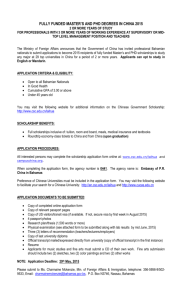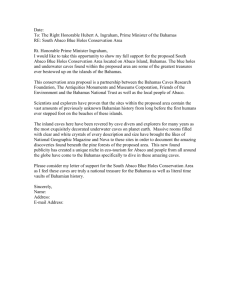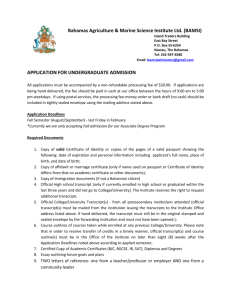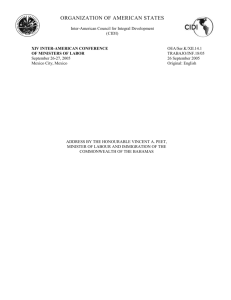Developments of capital markets became a priority in many
advertisement
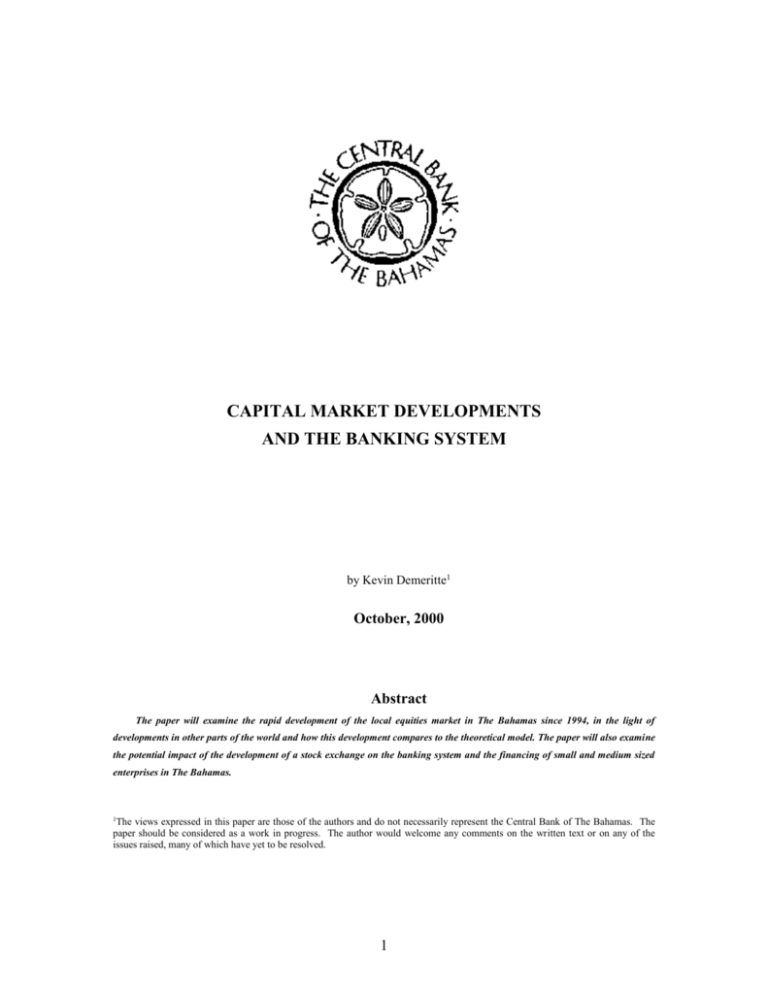
CAPITAL MARKET DEVELOPMENTS AND THE BANKING SYSTEM by Kevin Demeritte1 October, 2000 Abstract The paper will examine the rapid development of the local equities market in The Bahamas since 1994, in the light of developments in other parts of the world and how this development compares to the theoretical model. The paper will also examine the potential impact of the development of a stock exchange on the banking system and the financing of small and medium sized enterprises in The Bahamas. 1 The views expressed in this paper are those of the authors and do not necessarily represent the Central Bank of The Bahamas. The paper should be considered as a work in progress. The author would welcome any comments on the written text or on any of the issues raised, many of which have yet to be resolved. 1 CAPITAL MARKETS DEVELOPMENTS AND THE BANKING SYSTEM INTRODUCTION As recently as 1989, before the Wall came down, stock markets were painted by Marxists/Leninists in general and Communists in particular, as the pre-eminent symbol of capitalist greed and the continued dominance of the rich over the poor. Now ten years after the collapse of the Soviet Union, development of capital markets have become a priority in many developing countries including The Bahamas. The new emphasis on equity markets was driven by the failure of past non-market based strategies and the realization of the potential role that private initiative and capital markets could play. Capital markets have proved, in developed countries, to be remarkably efficient at bringing savers and borrowers together. As a consequence, many developing countries are also looking to local equity markets to provide conditions conducive to attaining more efficient risk sharing and resource allocation as well as mobilizing and improving the structure of domestic finance. Such appears to be the case in The Bahamas, where there has been a flurry of new issues coming to the market, and just as eagerly taken up by the local investing public. Although shares have been available to the general public in The Bahamas as early as 1969, with the issue of New Providence Development Company, they have only become popular as investment vehicles since the Global Bahamas Holdings and the Bank of The Bahamas initial public offerings in 1994. However, since that time, no fewer than 16 companies have come to market as well as three domestic equity-based mutual funds and the first ever Paradise Island Bridge Bond Issue. Not counting the mutual funds and the bond issue, these companies have raised in excess of $170 million, with the market value of 2 those new issues alone exceeding $360 million. (See Table 1.) As at end 1999, the total capitalization of the “over–the-counter” (OTC) market in The Bahamas including new as well as existing issues was estimated to have exceeded $1.3 billion. It is interesting to note that this is the same as the combined value of the total of outstanding Bahamas Government Registered Stock and Bahamas Government Treasury Bills. There is no reason to think that in the near future, if current trends continue, that the market capitalization of equities will come to dwarf that of the fixed income market. The rapid development of this equity market has been in concurrence with the development of specialized institutions to service this industry, new registrars and transfer agents and the development of a local stock index. This index, “FINDEX”, created by Fidelity Capital Markets Limited, one of two local brokerage houses, has measured the growth of the nascent market since January 1994 and has shown an overall appreciation in excess of 20% each year since inception. The emergence of the OTC market has coincided with, and in some cases helped accelerate government initiatives to enact securities and mutual funds legislation, and the establishment of create a Securities Board, now the Securities Commission, to oversee the development of capital markets and to take steps necessary towards the establishment of a local stock exchange, expected on stream in 2000. There has been considerable discussion about this rapidly developing equities market in The Bahamas. However, consensus has not yet been achieved in regards to several questions: 3 Is this development a product of evolving economic conditions, general financial liberalization or liberalization of the banking sector in particular? Will equity finance displace the traditional dominance of bank financing in The Bahamas? What is abundantly clear, at least in retrospect, is that the development of the OTC equities market since 1994 appears to be driven by several factors: 1. The rapid growth of the macro-economy that produced an increase in overall wealth. 2. The longstanding limitation on overseas investments due to the high 25% premium on investment funds, leading to pent up demand for local investment opportunities. 3. The perception of below market returns on domestic deposits and government paper. 4. The long-standing complaint, whether accurate or not, of the reluctance of banks to finance small and medium-sized enterprises, due to the difficulty in risk evaluation, the inexperience of bankers in this type of financing and the comparative ease, familiarity and profitability of consumer lending and mortgage financing. The combination of enterprises looking for alternatives to bank financing and investors seeking alternatives to traditional Bahamian investment outlets seemed to be a match made in heaven. The Initial Public Offering of Global Bahamas in April 1994 and the 4 Government’s sale of 20% of the shares in the Bank of The Bahamas proved the catalysts for this process. British American and Cable Bahamas quickly followed in the first half of 1995, with the Government offering a further 30% of Bank of The Bahamas in October of that year. The equities boom was underway. But apart from ensuring a source of financing for some enterprises at potentially lower cost, what other impact might this development have had on the banking sector? LITERATURE REVIEW Goldsmith (1969)1 along with Shaw (1973)2 and McKinnon (1973)3 who pioneered work on financial sector liberalization and its effect on overall macroeconomic growth and development, asserted that financial deregulation, more particularly, liberalization of the commercial banking system would lead to higher savings, improved resource allocation and economic growth. While this is clearly understandable, there was no clear indication of the impact of capital markets on this process, or a meaningful response to whether the development of a stock market is inevitably detrimental to the health and welfare of the banking system. The financial sector in The Bahamas, has to some degree, followed the example of Japanese and German financial sectors that are bank-dominated. By and large the big foreign-owned branches have traditionally provided financing to select enterprises through lines of credit and overdrafts, often participating in management as well as monitored the client activities, acting as lenders, as well as supervisors in close cooperation with the government regulators. However, such an arrangement is not likely to 1 Goldsmith, R. (1969), Financial Structure and Development, New Haven Connecticut: Yale University Press . 2 Shaw, E. (1973), Financial Deepening in Economic Development, Oxford University Press, New York. 3 McKinnon, R. (1973), Money and Capital in Economic Development, Brookings Institution, Washington, D.C. 5 be sustainable in the rapid developing economy of The Bahamas. It is no surprise that the similar bank-dominated systems, both in our region as well as the rest of the World, have experienced serious strain in recent years with new emphasis on reforming and global integrating their capital markets that is a move away from bank finance. But does these developments sound the death knell for domestic banking that has nurtured and supported the Bahamian economy for so long? To answer this question we need to revisit the Shaw-McKinnon 1973 model, which, was extended to include general capital market liberalization, by several authors, notably Vihang Errunza (1974, 1979)4. Errunza explicitly considered the role of securities markets in economic development. He argued that through the market price mechanism, more efficient risk sharing and the accumulation and dissemination of vital information would improve resource allocation. As markets develop we should expect to see the emergence of specialized institutions and instruments, increased liquidity, and diversification opportunities which would raise savings rates, capital accumulation and enhanced production possibilities directly as well as through increased access to technology. All these factors are in fact positive developments for the banking system as it makes their “job” easier. It would seem therefore that an efficient capital market would in fact complement rather than constrain a liberated banking sector. It important to understand the relationship between capital structure and the level of development of the stock market and whether stock markets help or hinder the financing function of the banking sector. That is whether equity and debt finance complement each 4 Errunza, V. (1974), “Optimal International Portfolio Investments and the Development Process”, unpublished thesis, University of California, Berkeley. Errunza, V. (1979), “Efficiency and the Programs to Develop Capital Markets – A Brazilian Experience”, The Journal of Banking and Finance, December, pp. 355-382. 6 other or serve as substitutes. Results of Demirguc-Kunt (1992)5 suggest a positive and significant relationship between firm leverage and stock market development. Equity finance will increase the borrowing capacity of firms through risk sharing and may raise the quality and quantity of bank lending through timely and systematic information flows. More recently, Demirguc-Kunt and Levine (1995)6 find that the level of stock market development is highly correlated with the development of the banks, non-banks, insurance companies and private pension funds. Thus, debt and equity finance should be viewed as complements-–a natural progression as development proceeds–-providing finance with characteristics. In a comprehensive study, King and Levine (1993)7 document that the financial sector development (size of the banking sector) is robustly correlated with current and future economic growth In a recent study, Levine and Zervos (1995)8 find that stock market and banking development indicators predict long-run growth and that the two sectors provide different bundles of financial services. To summarize, capital markets can play an important role in economic development. A well functioning stock market would help privatizations by facilitating efficient valuation and allocation of state-owned assets among local and foreign investors. Other benefits that could be expected from developing equity markets include, facilitating foreign direct investments and other forms of foreign equity participation. Indeed, a well functioning local market is a precondition for attracting foreign portfolio investments (FPIs). 5 Demirguc-Kunt, A. (1992), “Developing Country Capital Structures and Emerging Stock Markets”, Working Paper No. WPS-933, The World Bank. 6 Demirguc-Kunt, A and Levine R. (1995), Stock Markets and Financial Intermediaries: Stylized Facts”, Mimeo, The World Bank 7 King, R. and Levine, R. (1993), “Financial Entrepreneurship and Growth”, Journal of Monetary Economics, 32, pp.513-542. 8 Levine, R. and Zervos, S. (1995), “Policy, Stock Market Development, and Long-Run Growth”, Part I, Mimeo, The World Bank. 7 In the wake of the financial crises in Mexico and South-East Asia, FPIs or highly liquid short-term capital has become practically a curse word in many developing countries. However, what has been clear in hind-sight is that the nature of the money itself was not the problem, rather the use of short-term or “hot” money for long-term or development projects (i.e. a mismatch of maturities) provided the preconditions for crises. When combined with the penchant for borrowing in external currencies, generating income in local currencies within fixed rate regimes, and backed by implicit or explicit government guarantees, it now seems painfully obvious that these economies were inherently unstable and destined to fall once the market became aware of their vulnerabilities. The tragic set of circumstances and how to avoid them in the future are now common knowledge among central, investment and commercial bankers. THE BAHAMAS What is perfectly clear is that there are individuals and institutions in The Bahamas, both in the commercial and offshore sectors who are well aware of the above dangers. What is also clear is that it would be impossible for a local stock exchange to develop to any significant degree in The Bahamas without consideration being given to the large and dynamic offshore financial services sector. This sector while not directly involved in the local onshore economy, is more conversant with the requirements for a well functioning capital market. It has also been instrumental in encouraging the development of the Bahamas International Stock Exchange (BISX). The offshore sector’s expertise, training and contacts operating in international capital markets gives The Bahamas an immediate head start in terms of trained personnel, and a knowledgeable and sophisticated investor base. Further the transition from offshore advice to participation in local equities should 8 be relatively smooth. This is in contrast to many other developing country or emerging country exchanges that continue to experience growing pains as they seek to develop the investor base, identify and train personnel and fully acquaint populations and businesses with “ins and outs” of the equities markets. Finally, as regard the course that The Bahamas could be expected to take, one might reasonably question whether the current pace of IPOs will continue or even accelerate. In this regard, the medium term outlook for capital market development in The Bahamas is critically dependent on a number of considerations. The supply of new issues in The Bahamas will depend on the o owner/managerial considerations (control, accountability, monitoring and agency issues), o market environment (availability and cost of funds as compared to the banking system) o institutional considerations (government rules on issuance and availability of investment banking services). With respect to investor demand, o the market environment (e.g. transparent and adequate trading regulation, disclosure), o legal framework (e.g. minority protection, insider trading) o understanding of the markets (education). 9 However, above all else, the successful launch of the BISX and the privatization of Batelco and BEC will determine whether or not capital markets will continue to thrive in The Bahamas. The first of those conditions have been met with the successful launch of the domestic side of BISX in April, 2000. However, the privatization of Batelco and BEC are still pending. Assuming that the above conditions are met, the new issuance of equity will depend only on the tradeoffs between reward (return) – cost (risk) considerations on the part of the firm’s owners (shareholders). Fortunately for The Bahamas, the preconditions necessary for a well functioning market are now present to a high degree. These relate to the infrastructure; quality, timely and orderly information flows and investor sophistication. The infrastructure includes good quality accounting standards, well-defined property rights, a well functioning legal system, credible contract enforcement and properly qualified and trustworthy personnel. Quality, timely and orderly information flows relate to the asymmetries that allow undue advantage to insiders and may result in manipulation, a public scandal and the consequent loss of confidence in the marketplace. The investor sophistication deals with educating small participants about the long run nature of securities investments, the risk rewards of owning risky assets, portfolio management and in general reducing their disadvantage vis-à-vis insiders and professional investors. Regulatory measures (such as deposit insurance) that minimize the risk of market collapse are desirable to build investor confidence and prevent losses of non-market forces (such as fraud and market manipulation). 10 Two other sectors of the Bahamian capital markets that should be addressed and which are of critical importance to overall development are the fixed income market for government securities and the market for collective investment vehicles. Bahamas Government Securities Market9 Treasury bills (T-Bills) are short-term government securities, which, by law, may not have maturities exceeding twelve (12) months. Existing maturities are 90-day and 180day, and these instruments are issued by tender process conducted by the Central Bank, with acceptance given only to those bids at prices below or equal to a pre-determined reservation price. The auction adopts the multiple price format, meaning that successful bidders receive T-Bills at individual bid prices. Auction participants are commercial banks, the National Insurance Board, the occasional savings and loans institution (Other local Financial Institution) and the even more infrequent private individual investor. Bahamas Government Registered Stock (BGRS) were first issued in 1973 and since inception, have been issued at par, in multiples of 100, at a prescribed minimum investment of B$100.00. Unlike Treasury Bills, BGRS are issued by subscription, at rates determined by the Central Bank on behalf of the government, and announced at the release of the relevant prospectus. The maturity range of BGRS has generally tended between 10-20 years, although authorizing legislation provides for maturities of up to 60 years. Interest is paid semi-annually, at fixed or variable rates, with variable rates pegged to the prime-lending rate of domestic commercial banks. No ceiling exists on the amount of BGRS which government may issue. 9 Excerpts regarding the market for government securities are derived from “The Bahamas Government Securities Market: a proposed framework for routine analysis of issues” J. Justilien, Central Bank of The Bahamas, March 2000. 11 The total volume of government securities outstanding as at end-December 2000 include $132.5 million in T’bills, two-thirds of which is held by commercial banks, and $1.253 billion in long-term securities. Priority is generally given to smaller investors, with the remaining allocation being taken up by commercial banks, public corporations and insurance companies (primarily the National Insurance Board). What is clear however, that the market for government securities in The Bahamas is primarily a market for initial offerings only. If as hoped for, the secondary market for government securities is to develop concurrent with the rapid growth in the fledgling equities market, a number of critical issues must be addressed. At present, public information on the bond market is quite limited, although pre-issue information is considerably greater than for T-bill, primarily owing to the difference in issue mechanism. Initial recommendations for reform of the bond auction mechanism and as a first step towards preparation for creation of a viable secondary market via BISX may include: Establishment of an auction committee Access to a competitive and non-competitive bidding to provide for broader participation Issuance at par (better suited to an unsophisticated market for fixed income securities Selection of sealed-bid multiple auction format Reservation price, but not pre-announced Further diversification of maturity structure Auction calendars (based on Government’s cash flow projections) 12 Publication of auction results: amount offered, number and amount of bids submitted, amount allocated, range of maturities, average discount rate per maturity, quantity of non competitive bids. It is expected that over the medium term, as the capital market develops in The Bahamas, some or all of these issues will be addressed and we will see the growth and development of a secondary market for government securities on BISX. Benefits from secondary trading and listing on the stock exchange would include: A reference or benchmark for the pricing of other, more riskier securities Greater market depth and liquidity MUTUAL FUNDS-COLLECTIVE INVESTMENT VEHICLES10 Mutual funds are useful in broadening market participation among small investors, and could therefore promote growth and liquidity. In the case of The Bahamas, there is a burgeoning and well-established offshore mutual fund sector, while the local aspect of the fund is only now emerging, but has nonetheless produced encouraging results. At year-end 1999, total asset base of the 628 registered mutual funds approached $95.0 billion, with the offshore sector holding the vast majority and the domestic portion rather embryonic, but showing encouraging growth. The domestic potential for future growth and development of mutual funds is extremely positive, if the Bahamian economy continues to expand and experiences robust annual growth rates, along with low inflation and easing monetary policy. These factors provide the catalyst for higher disposable 10 Excerpts regarding the Mutual Funds Industry are derived from “The Impact of Mutual Funds on Domestic Financial Development” J. Lashell Adderley, Central bank of The Bahamas, March 2000. 13 incomes, thus the impetus for more sophisticated and aggressive savings and investment strategies. At year-end 1999, the two locally incorporated mutual funds companies combined NAV's approached $10.0 million--accounting for 0.3 percent of GDP and 0.5 percent of household's wealth--and were owned by a total of approximately 800 participants, spreading across 3.7 million shares. In so doing, mutual funds have opened the securities market to hundreds of Bahamians. At present, the two locally incorporated funds that are designed for Bahamian investors are The Fidelity Bahamas Growth and Income and Colina-MSI Preferred Investment Fund, Ltd. Financial Group, formerly Montague Securities International. A year after its inception, Fidelity Bank and Trust International Limited sponsored a second, and rather innovative, Bahamian dollar closed end mutual fund called Bahamas Property Fund Limited whose investment objective is long-term capital appreciation via investment in commercial real estate. The acquisition of the Bahamas Financial Center for $29.1 million is the Fund's first purchase and it is currently marketing a non-voting initial offering of up to 2,500,000 shares at $5.00 per share, with a minimum investment of $25,000. Dividends would be disbursed from rental income and any increase in the property's value. The successful initial public offering by Bahamas Property Fund has since boosted the assets base of local mutual funds by approximately $12.5 million to $20.0 million. Although the industry is guided by the both the Mutual Funds Act as well as the Securities Industries Act, the rapid growth and development of the industry as well as its inherent dual nature (domestic and offshore) provides ample concern regarding adequate 14 regulation and supervision without stifling innovation and the introduction of new products. For example, both Acts are silent on important areas that provide safety and liquidity to the industry such as the placement of investment assets, investment exposure limits, liquidity standards, and capital structure (with particular regards to leverage). Thus prudence in this regard is the responsibility of fund directors who impose selfgovernment/regulation. Although the domestic industry is small, the securities market is very volatile. Consideration may be given to prudential guidelines such as the ones listed above rather than left up to the market's discretion. Alternatively, if the Securities Commission prefers the concept of self-regulation, organizing a Self Regulatory Organization (SRO), similar to that of the Canadian model could prove to be prudentially sound. Otherwise, a complementary approach to additional regulations could be the implementation of private sector risk ratings along with fulldisclosure which would allow investors to make more informed decisions. Similar to the fixed income market, the potential for the securities industry in The Bahamas is enormous and the scope for development significant. The expected listing of offshore mutual funds on BISX as early as the first quarter of 2001 highlights this development. The regulatory authorities as well as market players needs to remain vigilant regarding the reputation of such as new and rapid developing sector, particularly in light of recent allegations from several multi-lateral agencies regarding the use of facilities for tax evasion and money laundering purposes. Nevertheless, it is expected that the industry will prove to be a major component in the overall development of the capital market in The Bahamas. 15 CONCLUSION In summary, capital market developments have advanced by to an extraordinarily degree over the past five years. Enterprises who may have been shut out of bank financing or who were simply looking for lower financing cost realized the opportunity available to them and brought to market a host of new issues. In addition to equity issues there has been the emergence of several local equity-based mutual funds including at least one “closed-end” property fund and new instruments and institutions emerging to serve the needs of this nascent sector. Bahamians everywhere now appear to be eagerly awaiting the next new issue and anticipating the privatization of Batelco expected in 2001 and BEC in 2002. These issues should provide depth and liquidity to an already reasonably active over-the-counter market. The amounts raised and the price appreciation of these new issues has been a clear indication of pent-up investor demand for increased alternatives for investable funds. But for this sector to ever flower to full maturity, and to take its place alongside the banking industry as partners in the financing of small and large-scale businesses, the BISX must come into effect for both the local and offshore market. The Bahamas has already shown that the preconditions for success are already in place. The accounting, legal and property rights standards have been an integral part of our economy for many years. The fiscal situation, monetary and macroeconomic conditions are at their most favorable. It is only necessary for the legislative and regulatory and technical hurdles to be overcome. The year 2000 is a watershed year for capital market developments and the emergence of The Bahamas as a first world economy. It is only through the development of first-rate capital markets can we hope to obtain the maximum benefits of resource 16 allocation and mobilization, increased competition and efficiency, risk sharing improved project evaluation and lower cost of capital mobilization. But the capital market in The Bahamas has by no means achieved a state of nirvana and there remain considerable hurdles to overcome. The preparation for the privatization of BaTelCo, has been a considerably slow and painful process, even delayed on several occasions. Originally scheduled for late-1999, the government has announced a new privatization date sometime in 2001. Because the privatization of the electricity utility, BEC, has been announced to take place after the sale of the telephone utility, it too has been delayed more than two years. These two issues in particular, were expected to provide a measure of depth and liquidity that the market is currently lacking, and the full flowering of BISX cannot come about with the said liquidity. Secondly, the anticipated launch of the international side of the exchange has yet to come about. This sector, expected to dwarf the domestic side by orders of magnitude, continues to await the resolution of issues relating to exchange control regulations currently in place and capital account convertibility. Further, BISX International even when fully on line, would not address domestic side issues which are more central to the intermediary role of the capital markets vis-à-vis development. Finally, in June of this year, The Bahamas was “black-listed” by several multilateral bodies as a “tax haven”, a jurisdiction engaged in “unfair tax competition” and a potential centre of money laundering activities. In additional to the overall chill that this “blacklisting” has had on the financial services industry, it has co-opted the attention and the resources of all interested players to resolve the issue as expeditiously as possible. Therefore, the regulatory agencies, like the Central Bank and the Securities Commission, 17 the legislative bodies of the government and private industry groups have placed all other issues on hold pending the outcome of efforts to be removed from the “black list”. It is hoped that the success of these efforts will be realized when these external bodies meet to review progress made in addressing their concerns sometime in 2001. Capital market developments in The Bahamas will essentially stagnate until such time as this issue is resolved. There is no certainty as to what the future holds for capital market developments in general and equities in particular but The Bahamas has built a solid foundation and are putting in place the necessary conditions conducive for the orderly development of the sector. Assuming the financial services sector receives a clean bill of health from the OECD, the FATF, FSF and other bodies, the future should be easier to discern. Since the beginning of 2000 there has been the announcement of a new closed-end mutual fund—the Bahamas Property Fund—a rights issue by Abaco Markets and the IPO of Benchmark (Bahamas) Ltd., the investment company. This diversity certainly bodes well for 2000 and with luck renewed discussions of the privatization of BaTelCo and BEC will materialize soon. Enormous growth and development of both offshore and especially domestic mutual funds of all types. In fact the recent introduction of Fidelity’s Bahamas Property Fund a type of Real Estate Investment Trust might be just the tip of the iceberg in terms of innovative mutual fund products. We certainly can expect to see a secondary market in government paper for both bonds as T-bills. 18 The development of an equities market as well as a secondary market for government paper should encourage the issuance of corporate debt paper in both the primary and trading in the secondary market. This should go well beyond the current rare offering of bonds to finance the new Nassau-Paradise Island bridge. As regard the likelihood of a significant market for derivative products, this will probably have to wait for another 7-10 years as the market become more sophisticated and issues relating to the convertibility of the Bahamian dollar, liberalization of the capital account are resolved. In terms of monetary policy, a deep, broad and liquid fixed income market, especially in government bonds and T-bills, should provide the Central Bank with greater flexibility in terms of instruments of monetary policy. Then this would open up debate on direct versus indirect monetary instruments and on the appropriate targets of monetary policy. Capital market developments are also expected to encompass emergence of more specialized institutions, facilitating new products as well as advice. There is an old Chinese curse that is loosely translated as “may you live in interesting times” Now whether this will prove to be a curse of a blessing for The Bahamas, one thing is certainly true, we are indeed living in interesting times. 19 REFERENCES Atje R. and Jonanovic B. (1993), “Stock Markets and Development”, European Economic Review, 37, pp. 632-640 Barro, R. (1991), “Economic Growth in a Cross Section of Countries”, Quarterly Journal of Economics, 56, pp.407-443 Barro, R., Fama, E., Fischel, D., Meltzer, A., Roll, R., Telser, L. (1989), “Black Monday and the Future of Financial Markets”, Mid-America Institute for Public Policy Research Inc., Chicago, Illinois. Bekaert, G. and Harvey, C. (1995), “Time-varying World Market integration”, Journal of Finance, 50, pp.403-444. Bekaert, G. and Harvey, C. (1998), “Foreign Speculators and the Emerging Equity Markets”, unpublished working paper, Stanford University, California. Campbell, J. and Hamao, Y. (1993), “Changing Patterns of Corporate Financing and the Main Bank System in Japan”, Mimeo, February. Chapple, S. (1990), “A Sequence of Errors? Some notes on the Sequencing of Liberalization in Developing Countries”, UNCTAD Discussion Paper, No. 31. Cho, Y. (1986), “Inefficiencies from Financial Liberalization in the Absence of Well-Functioning Equity Markets,” Journal of Money, Credit and Banking, 18, pp. 191-199. Claessens, S., (1993), “equity Portfolio Investment in Developing Countries: A literature Survey”, Working Paper No. wps-1089, The World Bank. Claessens, S,, Dooley, M., Warner, A. (1993), “Portfolio Capital Flows: Hot or Cool?”, Mimeo, The World Bank, Washington, D.C. Demirguc-Kunt, A. (1992), “Developing Country Capital Structures and Emerging Stock Markets”, Working Paper No. WPS-933, The World Bank. Demirguc-Kunt, A and Levine R. (1995), Stock Markets and Financial Intermediaries: Stylized Facts”, Mimeo, The World Bank. Edwards, S. (1987), “Sequencing Economic Liberalization in Developing Countries”, Finance and Development, March, pp. 26-29. Errunza, V. (1974), “Optimal International Portfolio Investments and the Development Process”, unpublished thesis, University of California, Berkeley. Errunza, V. (1979), “Efficiency and the Programs to Develop Capital Markets – A Brazilian Experience”, The Journal of Banking and Finance, December, pp. 355-382. Errunza, V. (1993), “Capital Markets, Foreign Portfolio Investments and Economic Development”, UNCTAD Discussion Paper 93-54499, Geneva. Errunza, V. (1999, “Foreign Portfolio Investments in Economic Development” unpublished paper presented at conference Is Globalization of Capital Markets a Boost or Hindrance to Development at Columbia University, New York. Errunza, V. and Losq, E. (1985), “International Asset Pricing Under Mild Segmentation: Theory and Test,” Journal of Finance, 40, pp. 105-124. 20 Errunza, V. and Losq, E. and Padmanabhan, P. (1992), “Tests of Integration, Mild Segmentation and Segmentation Hypotheses”, Journal of Banking and Finance 16, 949-972. Errunza, V., Hogan, K. and Hung, M-W. (1995), Characterizing World Market Integration Through Time”. Unpublished working paper, McGill University, Montreal, Canada. Errunza, V., Senbet, L. and Hogan, K. (1998), “The pricing of Country Funds From Emerging Markets: Theory and Evidence, International Journal of Theoretical and Applied Finance 1, 111143. Errunza and Miller (1998), “Market Segmentation and the Cost of Capital in international equity Markets”, Working Paper, McGill University. Frenkel, J. (1982). “The Order of Economic Liberalization: A Comment”, in K. Brunner and A. Meltzer (eds.) Economic Policy in a World of Change, Amsterdam, North-Holland. Frenkel, J. (1983), “Panel Discussion on the Southern Cone”, IMF Staff Papers, 30 pp. 164-173. Fry, M. (1988), Money, Interest and Banking in Economic Development, Baltimore, Johns Hopkins University Press. Goldsmith, R. (1969), Financial Structure and Development, New Haven Connecticut: Yale University Press. Haque, N. and Montiel, P. (1990), “How Mobile is Capital in Developing Countries?” Economic Letters, 33, pp. 359-362. Haque, N., Lahiri, K. and Montiel, P. (1990), “ A rational Expectations Macroeconomic Model for Developing Countries”, IMF Staff Papers, September, pp. 537-559. Henry, P., (1998), “Stock Market Liberalization, Economic Reform, and Emerging Market Equity Prices”, unpublished working paper, MIT, Cambridge, MA. Kang, J-K. and Stulz, R., (1996), “How different is Japanese Corporate Finance? An Investigation of the Information Content of New Security Issues”, Review of Financial Studies 9, 100-139. King, R. and Levine, R. (1993), “Financial Entrepreneurship and Growth”, Journal of Monetary Economics, 32, pp.513-542. Levine, R. (1992), “Financial Structures and Economic Development,” Working Paper No. WPS849, The World Bank. Levine, R. and Zervos, S. (1995), “Policy, Stock Market Development, and Long-Run Growth”, Part I, Mimeo, The World Bank. Mayer, C. (1988), “New Issues in Corporate Finance,” Eiropean Economic Review, June. McKinnon, R. (1973), Money and Capital in Economic Development, Brookings Institution, Washington, D.C. Mathieson, D. and Rojas-Suarez, L. (1992), “Liberalization of the Capital Account: Experiences and Issues,” Working Paper No. 92-46, International Monetary Fund. Merton, R., (1987), “Presidential Address: A simple Model of Capital Market Equilibrium with Incomplete Information”, Journal of Finance 42, 483-510. Mullin, J. (1993), “Emerging Equity Markets in the Global Economy”, Working Paper, Federal Reserve Bank of New York. 21 Obstfeld, M. (1994), “Risk-Taking, Global Diversification, and Growth”, American Economic Review, 84, pp. 1310-1329. Remolona, E., McCauley, R., Ruud, J. and Iacono, F. (1992-93), “Corporate Refinancing in the 1990s”, FRBNY Quarterly Review, Winter. Rybczynski, T. (1993), “The Development of European Capital Markets: The Main Trends and Their Implications”, Revue de la Banque/Bank-en Financiewezen, No. 1, pp.23-32. Sala-I-Martin, X. (1997), “I Just Ran Two Million Regressions”, American Economic Review, 87, pp.178-183. Shaw, E. (1973), Financial Deepening in Economic Development, Oxford University Press, New York. Shiller, R. (1981), “Do Stock Prices Move Too Much to be Justified by Subsequent Changes in Dividends?”, American Economic Review, 71, pp. 421-436. Singh, A. (1992), The Stock Market and Economic Development: Should Developing Countries Encourage Stock Markets?”, UNCTAD Discussion Paper, No. 49. Singh, A. and Hamid, J. (1991), “Corporate Financial structures in Developing Countries”, Washington, D.C., Economics Department, IFC. Somel, C. (1992), “Finance for Growth: Lessons from Japan”, UNCTAD Discussion Paper No. 44. Stulz, R., (1997) “International Portfolio Flows and Securities Markets”, Unpublished working paper no. 97-12, Ohio State University. Summers, L. (1986), “Does the stock market Rationality Reflect Fundamental Values?”, Journal of Finance, 41, pp.591-601. Sweeney, R. (1993), “Capital Controls in Liberalizing Countries”, Working Paper, Georgetown University, March. Tesar, L. and Werner, I.(1993), “U.S. Equity Investment in Emerging Stock Markets”, Mimeo, The World Bank, Washington, D.C. 22 Table 1. Capital Market Developments Initial Public Offerings 1969 - 1999 COMPANY Offer Date Cable Bahamas - ord. Cable Bahamas - 8% cum pref. # of Issued Shares Offer Par price value % of total Capital 30-Dec-99 30-Dec-99 raised 12-Jun-95 12-Jun-95 20,000,000 10,000 $1.00 $1,000.00 $1.00 $1,000.00 100% 100% $20,000,000 $10,000,000 Market Capitalisation. Colina* $7.23 Fidelity* $7.25 Price Apprec. $145,000,000 625.00% 06-Oct-97 2,400,000 $5.25 $1.00 40.0% $12,600,000 $6.20 $6.65 $15,960,000 26.67% British American 10-May-95 5,000,000 $2.00 $0.30 60.0% $10,000,000 $2.53 $2.53 $12,650,000 26.50% CIBC 22-Sep-97 5,000,000 $6.00 $0.10 10.0% $30,000,000 $9.05 $9.15 $45,750,000 52.50% $4.90 $4.90 $4.95 $4.95 $14,850,000 $9,900,000 98.00% 147.50% $11.93 $11.95 $29,875,000 99.17% $2.83 . $1.58 $2.75 $8,250,000 0.00% $1.68 $6,585,600 68.00% $4,751,533 18.33% Abaco Markets 31-Jul-95 250,000 $100.00 $100.00 02-Oct-95 28-Sep-94 3,000,000 2,000,000 $2.50 $2.00 $1.00 $1.00 30.0% 20.0% $7,500,000 $4,000,000 ICD Utilities 07-Oct-96 2,500,000 $6.00 $0.10 50.0% $15,000,000 Doctors Hospital 05-Mar-99 3,000,000 $2.75 $1.00 Global Bahamas Holdings 11-Apr-94 3,920,000 $1.00 $1.00 30.0% $3,920,000 FamGuard Corp 30-Mar-98 1,338,460 $3.00 $0.20 15.7% $4,015,380 $3.50 $3.55 FINCO 02-Mar-84 1,333,334 $3.00 $1.00 33.3% $4,000,002 $33.98 $34.25 RND Holdings 09-Nov-98 2,500,000 $2.50 $0.01 29.4% $6,250,000 $3.33 $3.33 $8,325,000 33.20% Commonwealth Bank - pref Bank of The Bahamas Bank of The Bahamas $25,000,000 $8,250,000 $45,666,690 1041.67% 01-Jul-99 2,100,000 $5.00 $0.01 25.0% $10,500,000 $6.18 $6.10 $12,810,000 22.00% J S Johnson 10-Mar-96 1,240,000 $3.50 $0.01 15.5% $4,340,000 $6.05 $6.10 $7,564,000 74.29% Bahamas Supermarkets 19-Jun-89 200,000 $13.50 $1.00 4.4% $2,700,000 $20.95 $22.23 $4,446,000 64.67% New Providence Development* 21-May-69 2,000,000 $1.00 $1.00 8.3% $2,000,000 $1.59 $3,180,000 59.00% Freeport Oil Company Limited (FOCOL) * Nov 14, 1997 offer made by ENAJ Int'l Ltd.to purchase all outstanding ordinary shares of New Providence Development Co. * Prices are the avergage of bid and ask 23
